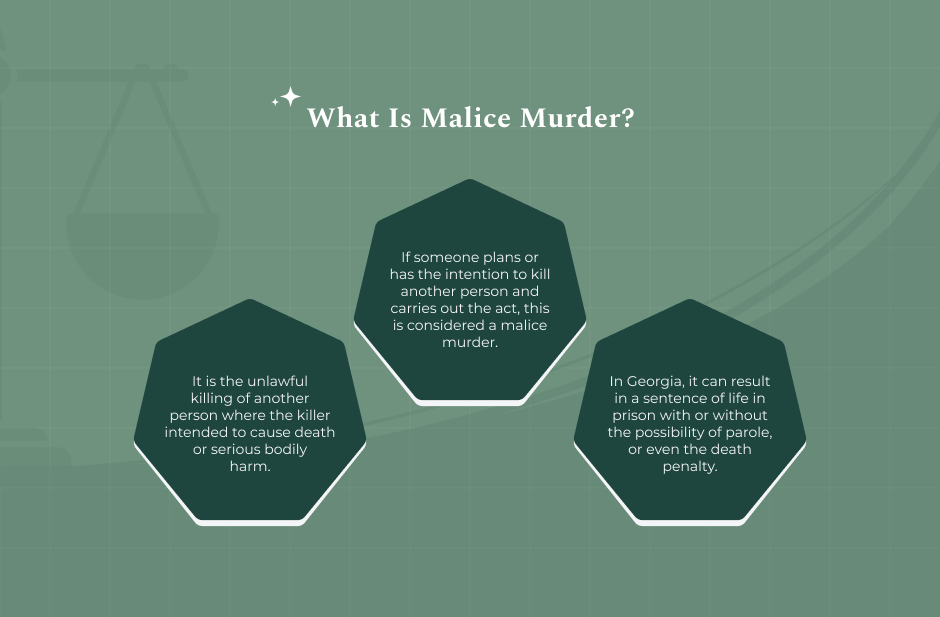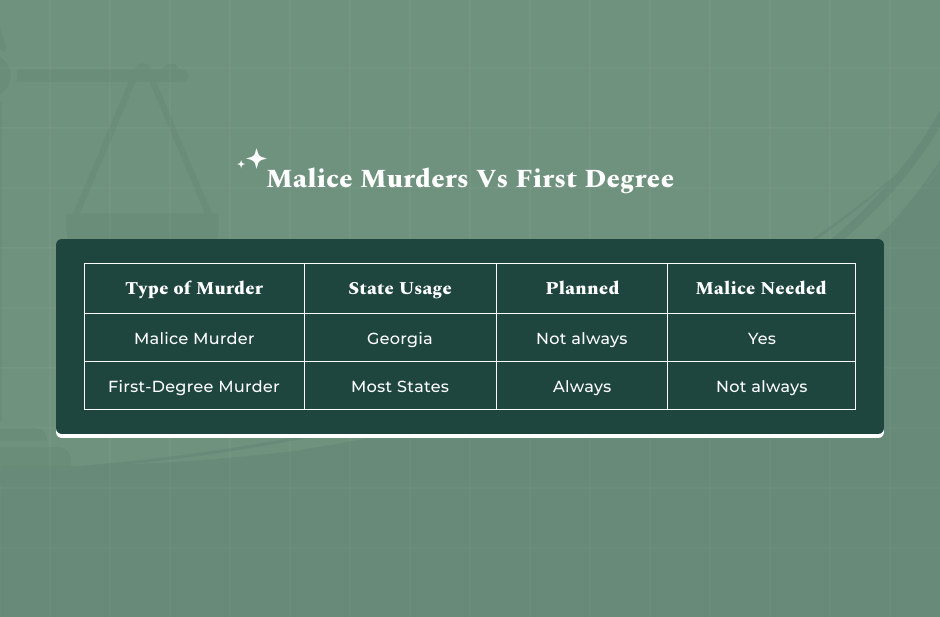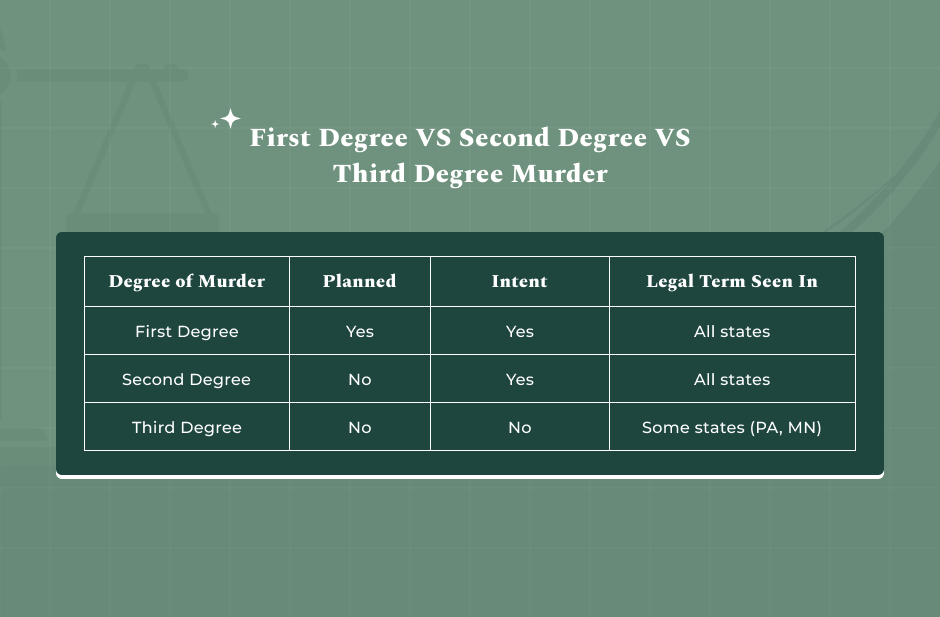Malice Murders Vs First Degree Murder— these are the two topics that most people scratch their heads around when trying to understand the charges!
When someone loses their life, the justice system kicks in to figure out what really went down. Who did it? Why did it happen? And how bad was it? That’s how the law decides what kind of crime it is.
Now, two terms that trip people up all the time are “Malice Murder” and “First-Degree Murder.” They sound kind of alike, right?
However, legally, they’re not exactly the same—and the punishments? Well, it’s a totally different ballgame.
So, if you’re just curious, watching a crime doc, or maybe even trying to make sense of something that happened around you, you are in the right place!
In this article, I will explain the difference between malice murders vs first degree murder, especially in relation to laws in Georgia. So, keep on reading this blog till the end…
What is Malice Murder?

Let’s start with malice murder. It’s a term used mainly in Georgia, and it means someone killed another person on purpose—like, they meant to do it. Not by accident. Not in self-defense. Just flat-out intentional.
To make things easier for you to understand, let me give you a hypothetical situation! Imagine this: someone acts out of cold anger or pure hatred, doesn’t care about what happens next, and kills someone.
Now THAT’S malice murder. No excuses, no justifications. Just deliberate harm.
What Are The Key Elements Of Malice Murder?
To call something a malice murder in court, the law looks for a few very specific things:
| Element | What It Means |
| Intent | The person meant to kill—no “oops” involved. |
| No legal excuse | They didn’t kill in self-defense or by accident. |
| Malice aforethought | The killer had a nasty mindset—anger, hatred, or just didn’t give a damn. |
Now, there are two types of malice here:
- Express Malice: The person literally says it out loud or shows they want to kill someone. Like screaming, “I’m going to kill you!” before doing it.
- Implied Malice: The killer doesn’t say it, but their actions show they didn’t care if someone lived or died. It’s more like, “I don’t care what happens,” and someone ends up dead.
What Are The Potential Charges Of Malice Murder?
Georgia takes malice murder really seriously. We’re talking top-tier charges. If convicted, the punishments can include:
- Life in prison without parole (yep, never getting out)
- Death penalty (though that’s rare)
It’s considered the worst kind of murder in Georgia. No joke.
What Is First Degree Murder?

Now let’s look at first-degree murder. This is what most states outside Georgia call it when someone kills on purpose—but here’s the key part: they also planned it.
So imagine someone thinks about it, maybe even writes it down or buys a weapon, waits for the right moment… and then does it. That’s first-degree murder. Cold and calculated.
What Are The Key Elements Of First-Degree Murder?
This type of murder doesn’t just “happen.” It’s got some built-in steps:
| Element | Explanation |
| Premeditation | The killer planned it. It wasn’t spur-of-the-moment. |
| Deliberation | They thought it through—weren’t acting out of blind rage. |
| Intent | The person clearly meant to kill. |
Want some examples? Here they are:
- Hiding in the bushes waiting to attack someone.
- Slipping poison into someone’s drink
All of those show planning and intent—classic signs of first-degree murder.
What Are The Potential Charges Of First Degree Murder?
Just like malice murder, this charge packs a serious punch. Depending on the state, someone convicted could face:
- Life in prison.
- Life without parole.
- Death penalty (if the state allows it).
It’s one of the heaviest charges out there. A single verdict can mean spending the rest of your life behind bars—or worse.
What Is The Differences Between Malice Murders Vs First Degree?

While both malice murder and first-degree murder involve taking someone’s life on purpose, the biggest difference comes down to where and how these legal terms are used.
1. Where the Terms Are Used
Malice murder is a term specific to Georgia. You won’t really hear it used in most other states.
In contrast, first-degree murder is recognized and used widely across the U.S., making it the more common label for intentional, premeditated killings.
2. Definition and Intent
Another difference when it comes to malice murder vs first degree is also in the meaning of the words themselves.
Malice murder principally derives from “malice” — the person who committed the act must be of a “wicked mind.” This element can be just anger, hatred, or even indifference to the fact if someone will be alive or not.
What is peculiar here is that the killer certainly did not need to make a plan for the murder. A situation without any detailed preparation could still be regarded as murder if it was intentional and characterized by a malicious mindset.
On the contrary, first-degree murder is definitely committed with a plan involved. Premeditation and a clear intention must exist.
The person did not only react spontaneously, but they also thought over the situation, reached a decision, and maybe even went as far as to plan and prepare things for carrying out the act.
That detail of being methodically planned out is what makes the case different from the rest of the murder charges and what classifies it as the most severe criminal offense.
3. Legal Terms & Proof
The legal aspect of the situation is also quite different.
A malice murder case means that the prosecution side is obliged to show that the “malicious intention” was there, that the defendant “malicious intention” was present prior to the act.
However, in the case of first-degree murder, the focus is on showing the person’s intention to have committed the crime and that the act was carried out willfully.
The consequence is still the same here—the one is dead—but the legal process of proving the guilt can be very different, depending on the kind of the crime—malice or first degree.
What Are The Differences Between First Degree VS Second Degree VS Third Degree Murder?

Understanding the different levels of murder charges can feel overwhelming, but once you get the basics, it starts to make more sense.
Let’s start with first-degree murder, which is considered the most serious. This type of murder involves two big things: intent and planning. The person not only wanted someone dead but also took time to think about it and set a plan in motion.
It’s calculated and deliberate—like someone who poisons a victim or hides and waits to attack them. There’s no question that they meant to kill, and they knew exactly what they were doing.
Now, second-degree murder still involves intent, but it happens without any kind of premeditation. Think of it like this: someone gets into a heated argument, things escalate, and they lash out and kill the other person.
There wasn’t a plan to kill beforehand—it just happened in the moment, maybe out of rage or panic. It’s still intentional, but it wasn’t thought through or organized in advance.
Then there’s third-degree murder, which not every state recognizes, but places like Pennsylvania do. This type doesn’t usually involve intent to kill at all.
Instead, the person did something reckless or dangerous, knowing someone could get hurt, but didn’t actually set out to kill. A classic example would be driving drunk and hitting someone fatally.
They didn’t mean to kill anyone, but their careless actions led to a death, and that’s enough for a third-degree murder charge in states where it’s recognized.
Your Legal Guide: What Are Your Defenses In Malice Murders Vs First Degree?
If someone’s charged with malice murder or first-degree murder, a defense lawyer might explore several paths to help:
- Self-Defense: Maybe they felt genuinely threatened and acted to protect themselves.
- Insanity or Mental Illness: The person didn’t fully grasp what they were doing because of a mental disorder.
- No Intent to Kill: Yes, someone died—but maybe it wasn’t on purpose. Could downgrade the charge.
- Mistaken Identity: Wrong person accused. Happens more often than you’d think.
- Lack of Evidence: The prosecution just doesn’t have enough solid proof to back up their claim.
Knowing the difference between malice murder and first-degree murder can really open your eyes to how the justice system works.
Both are serious crimes, no doubt—but the legal approach changes depending on things like planning, mindset, and even which state it happened in.
So the next time you’re watching a legal drama, reading the news, or just find yourself in a deep conversation about true crime, you’ll know exactly what those terms mean—and why they matter.
Read More:
















